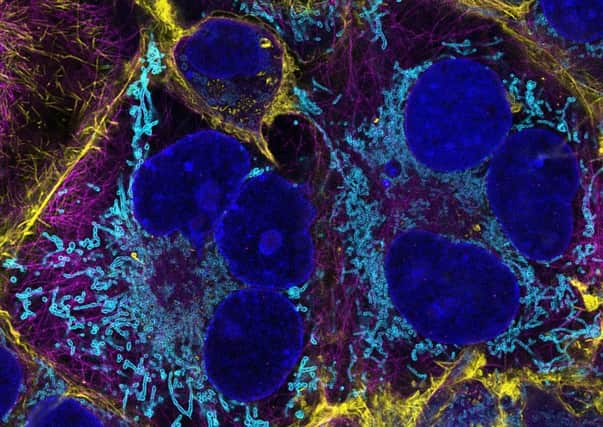Highest-resolution microscope in Scotland unveiled


The nanoscope, which can see objects ten times smaller than those visible to the most advanced light microscopes, is said to be the only instrument of its kind north of the Border.
Capable of creating 3D visualisations with a sharper, more informative image than other microscopes can provide, it will be used to investigate cancer cell biology, human genetic problems and autoimmune diseases.
Advertisement
Hide AdAdvertisement
Hide AdIt was unveiled by the Edinburgh Super-Resolution Imaging Consortium (ESRIC), a joint initiative between Heriot-Watt University and the University of Edinburgh.
Co-director of ESRIC, Professor Wendy Bickmore said: “The ability to visualise molecules in cells at such high spatial resolution, and the new capability to look at the relationship between different molecules simultaneously using different colours, provides an unprecedented opportunity to investigate the underlying molecular causes of human disease.”
Heriot-Watt University said the new stimulated emission depletion (STED) nanoscope – so-called because it “sees” things on the nano, rather than the micro scale – creates images at resolutions below the diffraction limit.
In traditional microscopy, resolution is limited by the diffraction of light.
The new system can produce an image in up to four colours simultaneously, allowing scientists to look at more than one gene, cell or structure at the same time.
Researchers say they will also be able to visualise biological events and structural details in living cells in real-time for prolonged periods. The team behind the project said they will also make the system available to global researchers across a range of specialities to study scientific questions relating to health and medicine, geology, biophysics, bioengineering, mathematics and neurobiology.
Professor Rory Duncan, principal investigator and co-director of ESRIC, said: “ESRIC was established as an international and inter-disciplinary super-microscopy consortium allowing researchers from around the world to come together and make the best use of the resources and equipment we have to the wider benefit of society.
“While our previous system allowed researchers to visualise genes, cells or organisms in one colour and one dimension, it did not allow for the study of living dynamics.”